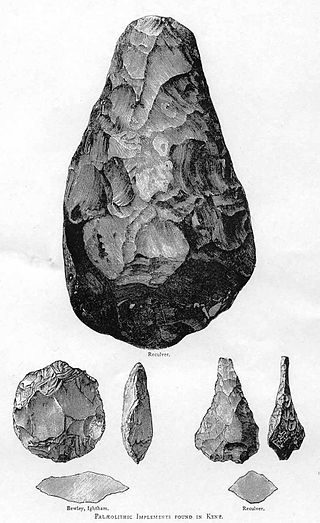Hand axe
stone tool From Wikipedia, the free encyclopedia
A hand axe is a stone tool of the Lower (early) and Middle Paleolithic Stone Age. It has two faces, is similar on both sides, and does not have a handle like a modern axe. It was held directly in the hand, perhaps wrapped in a piece of leather.


| Gray's Inn Lane Hand Axe | |
|---|---|
 Pointed flint hand axe from Gray's Inn Lane, London | |
| Size | 165 mm (6 in) long |
| Created | 350,000 years ago |
| Discovered | Gray's Inn Lane, London |
| Present location | British Museum, London |
History
The first stone tools were probably made by Australopithecines.[1][2] They are found in the Great Rift Valley of Africa from about 3.3 million years ago.[3][2] The hand axe cultures were preceded by an even older Oldowan culture of primitive stone tools (2.6 to 1.7 million years ago) in Africa.[4][5]
At least a million and a half years ago,[1] earlier species of man (like Homo erectus and Homo neanderthalensis)[6] began making hand axes. This became one of their most important tools. Hand axes are typical of the Acheulean and the Mousterian cultures.
In northern Pakistan, archaeologists have found 500,000-year-old Acheulean hand axes.[7] In eastern Asia, people occasionally made hand axes, but usually made choppers or flakes instead, according to new archaeological evidence from Baise in Guangxi, China.[8] The authors say "The stone tool assemblage shows close associations with the pebble tool industry... in South China".[8]
In 2008, archaeologists found twenty-eight 100,000-year-old hand axes in the North Sea off the coast of the United Kingdom.[9]
The Movius Line divides the Old World into two parts. To the west are the hand axe areas, and to the east are the chopper or flake-and-chip areas. Historians think there were at least two different cultural traditions.
Production

Older hand axes were produced by hitting a piece of stone with a stone hammer. This produced a thick stone tool with a curvy border. Later Mousterian handaxes were produced with a soft billet of antler or wood.[10] They had straight borders, and were much thinner and more symmetrical than older hand axes.[10]
An experienced flintknapper needs less than 15 minutes to produce a good-quality hand axe. A simple hand axe can be made from a beach pebble in less than 3 minutes.
Raw materials
Most hand axes were made of flint. Sometimes rhyolites, phonolites, quartzites and other coarse rocks were used as well, depending on what was available in the area. Obsidian was sometimes used,[11] but is not widely found. It produces a brilliant and extremely sharp blade, but it shatters more easily than flint.
Shapes
Hand axes have been found in several basic shapes, including ovals, triangles, and heart shapes. Archaeologists do not agree about why people used these different shapes.
Function
Hand axes were multi-purpose tools.[9] Many were used for butchering meat, according to research on hand axe artifacts' cutting edges. Butchering included extracting bone marrow (which would explain the tool's pointed end) and hacking through bone, muscle and tendons. Experiments at Boxgrove quarry seem to support this idea.
Neanderthals were hunters of large mammals such as mammoths. The same may be true of other hand axe cultures. This explains the need for such a heavy tool. Using a hand axe requires considerable strength, but Neanderthals had greater upper body strength than human species.
In studies done in the 1990s at Boxgrove, a butcher attempted to cut up a carcass with a hand axe. The hand axe proved to be perfect for getting at bone marrow, which is high in protein and vitamins and thus was highly prized as a food source.[12][13]
Related pages
References
Wikiwand - on
Seamless Wikipedia browsing. On steroids.
